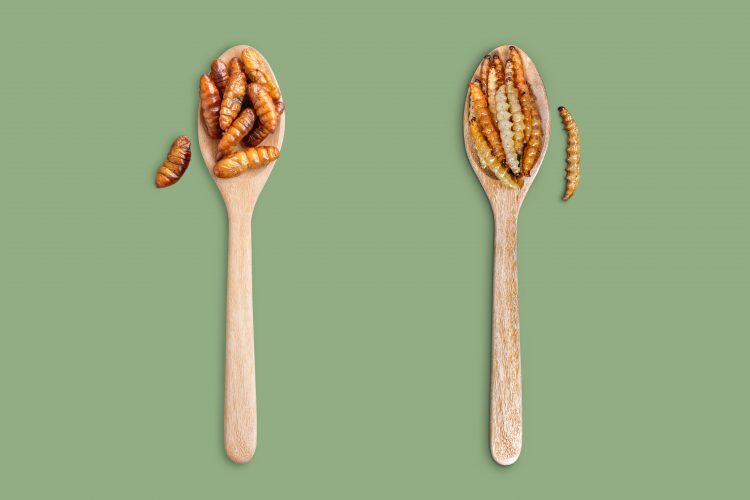Recent insect authorisation accelerate tailwinds for novel foods
- Like
- Digg
- Del
- Tumblr
- VKontakte
- Buffer
- Love This
- Odnoklassniki
- Meneame
- Blogger
- Amazon
- Yahoo Mail
- Gmail
- AOL
- Newsvine
- HackerNews
- Evernote
- MySpace
- Mail.ru
- Viadeo
- Line
- Comments
- Yummly
- SMS
- Viber
- Telegram
- Subscribe
- Skype
- Facebook Messenger
- Kakao
- LiveJournal
- Yammer
- Edgar
- Fintel
- Mix
- Instapaper
- Copy Link
Posted: 11 February 2022 | Christophe Derrien, Constantin Muraru, Maximilian Beiter | No comments yet
Constantin Muraru, Maximilian Beiter and Christophe Derrien offer insight on two new insect authorisations that the food industry need to know about.


The past 12 months were full of developments for the European insect sector: from the first two novel food authorisations covering yellow mealworm (SAS EAP Agronutris application) and migratory locust (Fair Insects B.V. (owned by Protix) application), to the most recent ‘green light’ by the College of Commissioners for two additional authorisations of new insect food products derived from house cricket and yellow mealworm (both underlying applications submitted by Fair Insects B.V.) which will come into force in the next few weeks. In this article, we provide a succinct update on the drivers behind these regulatory developments, implications and possible challenges ahead.
Main drivers for change
In the western world, eating insects – commonly referred to as entomophagy – is part of a larger trend that challenges our unsustainable dietary patterns and means of food production. Reared in efficient vertical farms, insect-derived products have a low environmental footprint and a reduced feed conversion ratio (FCR) – which means they eat very little throughout their lifecycle.
Insects are a healthy source of nutrition
Consumed by more than two billion people worldwide, insects are a sustainable and nutritious addition to human diets. The incorporation of insects and their derived ingredients into our eating habits brings numerous benefits – including that they contain all essential amino acids, are rich in minerals (such as iron), vitamins (B12) and fibres, as well as healthy fatty acids. Such products are also versatile – with applications in a range of products, such as bakery, snacks, meat analogues and sports nutrition.
Insect-based is safe
The four scientific assessments of the European Food Safety Authority (EFSA), which preceded the above-mentioned authorisations, confirmed the safety of such products intended for human consumption. These rigorous risk assessments entailed an evaluation of the scientific information and food characteristics by EFSA’s experts, as presented by insect producers.
The recent approval by the highest body of the European Commission (EC) for two additional insect novel food authorisations displays a strong political signal, building on EFSA’s conclusions that the products authorised do not pose safety risks. This positive feedback signals the recognition of EU officials for new sources of nutrition and acceptance of their role in accelerating progress on the ‘Farm to Fork’ objectives.
But what are the implications of these recent developments?
Who will benefit?
These developments represent significant milestones for the insect sector from Europe. They reward the efforts of those insect-producing companies, like Agronutris and Protix, that were involved throughout the application process in recent years, developing and aggregating scientific evidence that demonstrates the safety of these products.


Being versatile, insects can be cooked in numerous ways (boiled, fried, dried) and transformed into various ingredients (as whole insects, powder, oil, etc). Photo Credit -Essento
More tangibly, these four authorisations will pave the way for the wider commercialisation of edible insects across Europe. Firstly, they grant the applicants (and their commercial partners) the right to launch insect-derived products covered by each dossier on EU member states markets, and secondly, this serves to help ease the path for other insect novel food applications (eg, those presently under EFSA’s evaluation).
All novel food authorisations are product specific. This implies that an applicant has the right to commercialise the products covered by a dossier (and be included on the Union list of novel foods) – rather than any product derived from the respective insect species.
In addition, given that EFSA considered the confidential data used by the applicants (ie, to develop the four dossiers that led to the above authorisations) to be decisive in determining the safety of the end products, other insect producers may also place the same foodstuffs on the market, provided the two parties reach a commercial agreement (the latter producer has to comply with the conditions stated in the authorisation – used by the holder of the authorisation) and the EC formally approves the extension of this authorisation.
Presently, the applicants that obtained an EU authorisation (as well as their commercial partners purchasing products from them) can already place the products covered by the accompanying dossiers on the market (note: at the time of writing, this is the case for the yellow mealworm products of the EAP Agronutris authorisation and the migratory locust products of the Fair Insects BV/Protix authorisation).
So far, more than 20 insect novel food applications have been submitted to the EC. Four have led to authorisations, while nine others are presently under EFSA’s evaluation. In our view, the four granted authorisations will contribute to accelerating progress on the other dossiers – as, from a procedural and scientific point of view, these evaluations have many similarities.
The challenges ahead
When edible insects first appeared on European shelves, some consumers were suspicious – it was perhaps the first time they had encountered such food products on the market. Given time, however, it is plausible that many will be willing to experience the sensation of eating insect-derived products. Publicised information about the nutritional and environmental benefits of insects is perhaps contributing to a growing share of consumers incorporating insects into diets, alongside traditional types of food.
In this era of social media when information travels at supersonic speed, a remaining challenge is engaging in effective dialogue with consumers. Encircled by numerous labels, captivating slogans and trends, consumers are bombarded with information regarding the products they find online or on shelves. For insect producers – as newcomers in the field of nutrition – communicating clearly and effectively will be crucial.
Acceptable insect food products
Insects will certainly become part of consumers’ diets across the world; the question is, in what form? Being versatile, insects can be cooked in numerous ways (boiled, fried, dried) and transformed into various ingredients (as whole insects, powder, oil, etc).


Insects can be consumed in a variety of ways. Photo Credit – Jimini’s
The key benefit of insect-derived ingredients is that they can be incorporated into various staple products, including bread or pasta, while the fats can be used for frying or salads. Moreover, there is growing interest in developing products that resemble meat-based dishes such as insect-based burger patties; dairy products such as insect-derived milk; or even alcoholic drinks such as beer, liquors, etc – these possibilities bring such novel ingredients closer to the culinary heritage of consumers. The possibilities are numerous: from biscuits and other snacks, to sports nutrition – insects can contribute to making our diets healthier and more sustainable.
Are you looking forward to a sustainable and mouth-watering treat?
About the authors
Christophe Derrien is IPIFF Secretary-General and in charge of coordinating the advocacy and outreach activities of the organisation, regulatory developments and the general management of the Secretariat.
Maximilian Beiter is IPIFF’s EU Regulatory Affairs Manager. He is primarily in charge of insects as food developments. Among others, he is also responsible for the monitoring activities under the ‘EU Farm to Fork’ (F2F) strategy and outreach towards the European Parliament.
Constantin Muraru is IPIFF’S Communication and Research Manager, responsible for managing the overall communication strategy of the organisation, as well as the activities related to research funding opportunities. In addition, he is also in charge of international policy and outreach activities.
You might also like:
Related topics
Health & Nutrition, Insect Protein, Regulation & Legislation, Research & development, Sustainability









